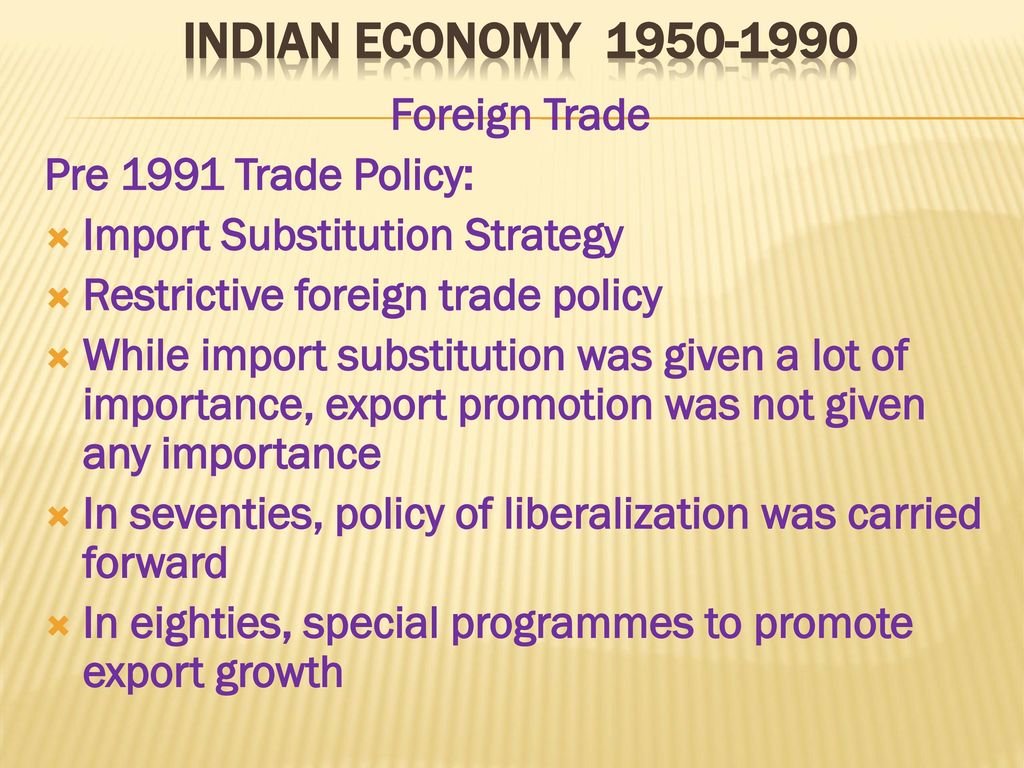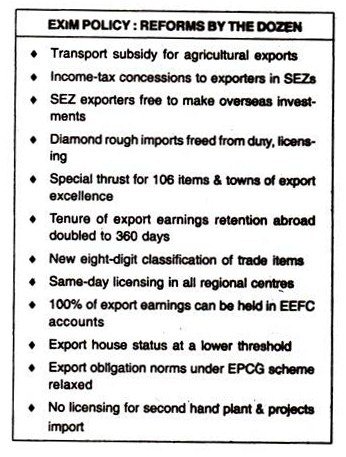India’s Export Policy: A Journey through the Pre-Reform Period
Introduction:
India’s economic landscape has undergone significant transformations over the years, and understanding the nuances of its export policy is essential to grasp the trajectory of its development. In this section, we’ll delve into the pre-reform period, a crucial chapter in India’s economic history, to explore the export policy that shaped the nation’s trade dynamics.
Table of Contents
The Pre-Reform Period:
The pre-reform era in India spans from independence in 1947 to the early 1990s when the country embraced economic liberalization. During this period, India adopted a mixed economy model, combining elements of socialism and state intervention in key sectors. This approach extended to the export policy that was designed to promote self-sufficiency and protect domestic industries.

The Three Phases of Export Policy:
Bimal Jalan classifies the export policy of the Government of India in the pre-reform period into three distinct phases: Phase 1 (upto the first oil shock of 1973), phase 2 (covering the period from 1973 upto a decade or so), and phase 3 ( the period after the above and covering roughly the latter half of the Sixth Plan and the whole of the Seventh Plan). The period of Phase 1 can be divided into two sub-periods : (a) 1952-66, and (b) 1966-73. The first sub-period covers the first three Five Year Plans and was characterized by an essentially passive export policy though some steps to increase exports were undertaken in the Third Plan.
Phase 2 can be considered to have begun in 1973 and lasted for about a decade. Phase 3 saw a more positive approach to export policy promotion strategy. While incentives for export policy production were enhanced on the one hand, export policy themselves were now being seen as an integral part of industrial and development policies.
Export Policy Promotion Policies: An Overall View
Important export policy promotion measures undertaken by the Government of India during the pre-reform period were as follows:
Cash Drawback System:
The object of the duty drawback system is to reimburse exporters for tariff paid on the imported materials and intermediates and central excise duties paid on domestically produced inputs which enter into export policy production.
Cash Compensatory Support (CCS):
This was introduced in 1966. It was designed to provide compensation for unrebated indirect taxes paid by exporters on inputs, higher freight rates, and market development costs.
Replenishment Licences:
In order to provide the export sector of the economy with access to importable inputs that enter into export production, at international prices, the import policy allowed special import facilities for registered exporters.
Advance Licences and Duty Exemption Scheme:
Advance licences facilitated imports of specified raw materials without payment of any customs duty. Such licences were available only against confirmed export policy orders and/or letters of credit.
EPZs and 100 per cent EOUs:
With a view to giving impetus to export policy drive, the government set up Export Processing Zones (EPZs) which provide almost free trade environment for export production so as to make Indian export products competitive in the world market.
Subsidies on Domestic Raw Materials:
The most important scheme in this category was the International Price Reimbursement Scheme (IPRS) for steel, which equalised the difference between international and domestic prices of steel obtained from domestic sources.

Fiscal Concessions for Exports:
Special fiscal treatment granted to export policy took two forms, that which related to the payment of indirect taxes, and that which related to the payment of direct taxes.
Export Credit and Assistance to EPCs:
Assistance was granted in the form of grants-in-aid to the Export Promotion Councils and approved organisations, export policy houses, consultancy organisations and individual exporters to undertake (a) market research, commodity research, area survey etc, (b) export publicity and dissemination of information, (c) trade delegations and teams, (d) participation in trade fairs and exhibitions, (e) establishment of offices and branches in countries abroad, (f) research and development schemes etc., and (g) any other scheme that would promote the development of market for Indian goods abroad.
Blanket Exchange Permit Scheme:
A Blanket Exchange Permit Scheme was introduced by the government in June 1987. The scheme aimed to give a major thrust to the country’s export policy promotion drive.
Import Substitution Industrialization (ISI):
In the initial years post-independence, India embraced Import Substitution Industrialization (ISI) as its economic strategy. The focus was on reducing dependence on foreign imports by fostering the growth of domestic industries. This policy aimed to stimulate economic development by producing goods domestically that were previously imported.
However, the emphasis on ISI led to a neglect of export-oriented strategies, limiting India’s engagement with the global market. The stringent licensing system further constrained the export sector, hindering its competitiveness on the international stage.
Trade Barriers and Quotas:
The pre-reform period witnessed the imposition of various trade barriers and quotas, ostensibly to protect domestic industries from foreign competition. While these measures were intended to shield fledgling industries, they inadvertently stifled innovation and competitiveness.
The quota system, for instance, allocated a fixed amount of foreign exchange for imports, constraining the range of goods that could be traded internationally. This approach hindered diversification and specialization, factors critical for thriving in the global market.
Monopoly Control:
The government played a dominant role in trade and commerce during the pre-reform period, leading to a system characterized by monopolistic control. Key industries were often nationalized, with the state acting as the primary player in trade transactions. This centralized control resulted in bureaucratic inefficiencies and a lack of dynamism in the export sector.
Impact on the Export Sector:
The export policies of the pre-reform era had mixed consequences for India’s economy. While they aimed to nurture domestic industries, the emphasis on protectionism hindered the country’s ability to tap into the benefits of international trade. India’s share in global exports remained modest, and the nation missed out on opportunities for economic growth through increased foreign exchange earnings.

Organisational Structure for Promotion of Exports
The organisational structure for promotion of exports includes a number of councils and organisations set up during the post- Independence period. These include: (1.) Export Promotion Councils, (2.) Commodity Boards, (3.) Agricultural and Processed Food Products Export Development Authority, (4.) Exports Houses, (5.) The Central Advisory Council on Trade, (6.) The Federation of Indian Export Organisations, (7.) The Trade Development Authority, (8.) The Indian Institute of Packaging, (9.) Export Credit and Guarantee Corporation of India, (10.) The Export Inspection Council,(11.) Trade Fair Authority of India, (12.) Public sector agencies like State Trading Corporation of India, Minerals and Metals Trading Corporation, Handicrafts and Handloom Export Corporation, Indian Motion Pictures Export Corporation etc. and (13.) The Indian Institute of Foreign Trade.
A Critical Evaluation of Export Policy
Absence of a Long-term Export Strategy
As noted earlier, phase 1 (i.e., the period from the beginning of the planning to the first oil shock of 1973) was characterized by export pessimism. In phase 2 (covering the period from 1973 upto a decade or so) more attention was paid to the export sector as it was realised that import substitution, in itself, would not be able to bring about a viability in India’s balance of payments.
Problems Confronting Primary Exports:
For a long period of time, primary products contributed a major portion of India’s export earnings. However, prospects of increasing exports of these commodities were limited on account of a number of external and internal factors.
Problems Confronting Non-traditional Exports:
Government of India had recognised quite early, and rightly so, that possibilities of increasing export earnings through expansion of primary exports are severely limited. Therefore it placed an increasing emphasis on the development of non- traditional exports.
However, exports of manufactured products also suffered on account of serious trading and production problems, faulty domestic policies and insufficient efforts.
Trading Problems:
Among the ‘trading problems ‘ one can mention external impediments which posed a problem of “entry” for the Indian manufacturers ( and manufacturers of other developing countries) in markets of industrialised countries.
Production Problems:
The most serious problem in this field is the lack of ‘technological dynamism’ in Indian industry. In spite of changes in the industrial and trade policies, most Indian firms continue to produce outdated products with inefficient production technologies.
Overvalued Exchange Rate
Tendulkar and Bhavani have raised another important point. According to them, exchange rate adjustment is a better option than import controls to manage the balance of payments deficits as it affects all tradables uniformly without discriminating against any sector.
The exchange rate remained overvalued most of the time in the pre-reform period. This made imports cheaper and exports unprofitable further contributing to current account imbalances.

The Way Forward:
The pre-reform period set the stage for a paradigm shift in India’s economic policies. Recognizing the limitations of a closed economy, the country eventually embraced economic liberalization in the early 1990s. Reforms aimed at dismantling trade barriers, promoting export-led growth, and encouraging foreign direct investment were initiated.
Conclusion:
In retrospect, the export policies of the pre-reform period in India were shaped by a desire for self-sufficiency and protectionism. While these policies had some short-term benefits, they also constrained India’s ability to integrate into the global economy. The subsequent shift towards economic liberalization marked a turning point, unleashing the potential for a more dynamic and globally engaged export sector. Understanding this historical context is crucial for appreciating the evolution of India’s economic policies and their impact on the country’s standing in the international arena.